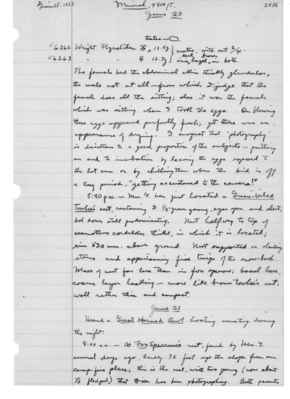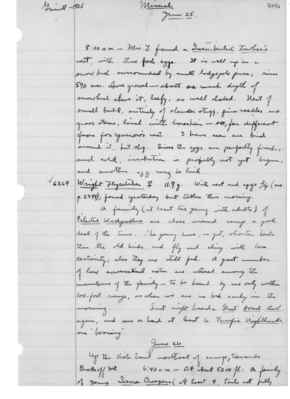Pages That Mention Great Horned Owl
1925: Joseph Grinnell's field notes
S2 Page 31
Collector: Grinnell-1925 Location: Mineral, 4800 ft., Date: June 20 Page Number: 2486
6262 Wright Flycatcher (male) ^testes [illustration] 12.5 g 6263 [Wright] [Flycatcher] (female) 12.7 g } mates, with set 2/4. iris ^dark hazel ^brown in both.
The female had the abdominal skin thickly glandular, the male not at all - from which I judge that the female does all the sitting; also it was the female which was sitting when I took the eggs. On blowing these eggs appeared perfectly fresh; yet there was an appearance of drying. I suspect that "photography" is disastrous to a good proportion of the subjects - putting an end to incubation by leaving the eggs exposed to the hot sun or by chilling them when the bird is off a long period, "getting accustomed to the camera!"
5:40 p.m. - Mrs. G. has just located a Green-tailed Towhee's nest, containing 3 1/3-grown young, eyes open and alert, but down still predominating. Nest halfway to top of ceanothus cordulatus thicket, in which it is located; rim 520 mm. above ground. Nest supported on slanting stems and appertaining fine twigs of the snow-bush. Mass of nest far less than in fox sparrow; basal loose, coarse layer lacking - more like brown towhee's nest; wall rather thin and compact.
June 21 Heard a Great Horned Owl hooting something during the night.
8:00 a.m. - At Fox Sparrow's nest, found by Mrs. G. several days ago, hardly 75 feet up the slope from our camp-fire place; this is the nest, with two young (now about 1/3 fledged) that Dixon had been photographing. Both parents
S2 Page 42
Collector: Grinnell - 1925 Location: Mineral Date: June 25 Page Number: 2496
8:00 a.m. - Mrs. G. found a Green-tailed Towhee's nest, with three fresh eggs. It is well up in a snow bush surrounded by small lodgepole pines; rim 590 mm. above ground - about as much depth of snowbush above it, leafy, so well shaded. Nest of small bulk, entirely of slender stuff, pine needles and grass stems, lined with horsehair - so, far different from fox sparrow's nest. I have seen one bird around it, but shy. Since the eggs are perfectly fresh, and cold, incubation is probably not yet begun, and another egg may be laid.
6264 Wright Flycatcher [female symbol] 11.9 g. With nest and eggs 3/4 (see p. 2494); found yesterday but taken this morning.
A family (at least two young with adults) of Pileated Woodpeckers are close around camp a good deal of the time. The young have, as yet, shorter tails than the old birds, and fly and cling with less certainty; also they are still fed. A great number of low conversational notes are uttered among the members of the family - to be heard by us only within 100-foot range, as when we are in bed early in the morning. Last night heard a Great Horned Owl again, and saw or heard at least 6 Pacific Nighthawks, one "booming".
June 26 Up the Vista Trail northeast of camp, towards Brokeoff Mt. 6:40 a.m. - At about 5200 ft.: A family of young Sierra Creepers (at least 4, tails not fully
S3 Page 41
Collector: Grinnell-1925 Location: La Grulla, 7,200 ft. Date: October 11, 1925 Page Number: 2584
6501 Townsend Junco (female sign) ad. 16.9g. Shot on rock in bush. 6502 Mountain Chicakdee (male sign) ad. 11.8g. Shot in pine. 6503 " " (female sign) ad. 11.4g. Shot in Salvia bushes. 6504 " " (female sign) ad. 11.4g. Shot on ground under willow. 6505 White-crowned Sparrow (male sign) im. 23.1 g. " " " " " 6506 Bluebird (male sign) im. 26.6g. Shot in cascara bush. 5 p.m. Our packer, José, has just come in to inform us that a mule is missing, so we will be two days late in changing location. But - "mañana" is the rule in this country! The feature of my day was a full close view of a Ferruginous Rough-leg (my gun was entirely out of commission at the moment!). The bird circled above me within 60 yards, showing its character well. It was the whitest hawk I ever saw. The whole under surface was white, save for sparse dark markings on the chest; The basal 2/3 of the tail was white, the terminal third being light dusky?; The under sides of the wings were white save for dark primary types and for dark mottlings in a transverse row at "wrist." Lamb and I have both seen this bird distantly in previous days, referring to it as "the white hawk." This is the only other buteonine besides the Red-Tails we have seen at this station. Saw a Great Horned Owl fly along the hillside at late dusk last evening. We hear their notes every night.


